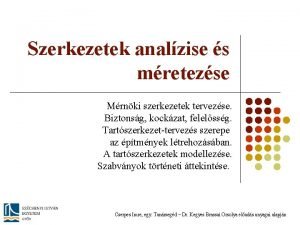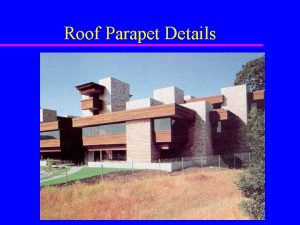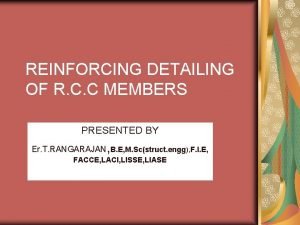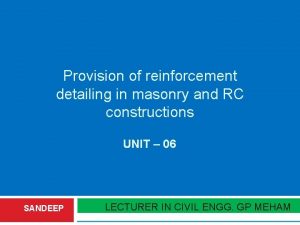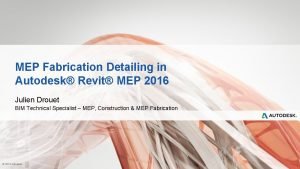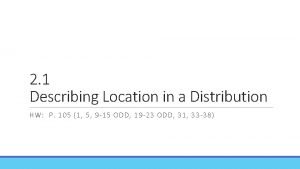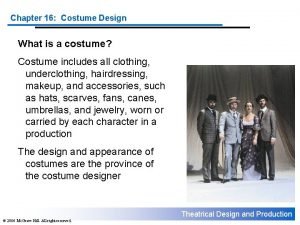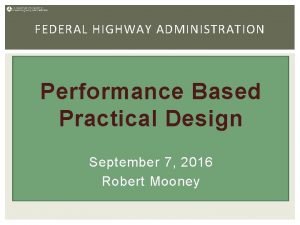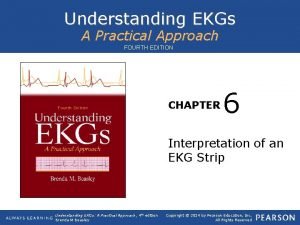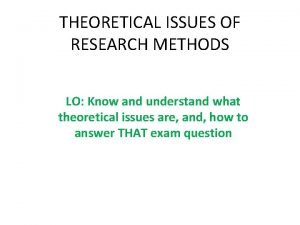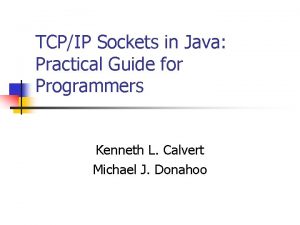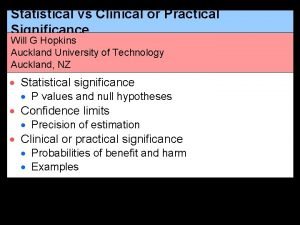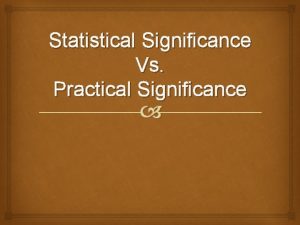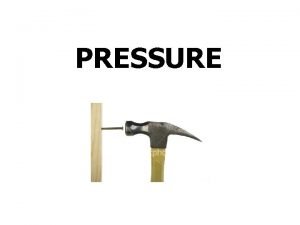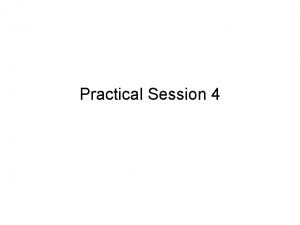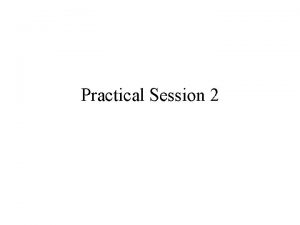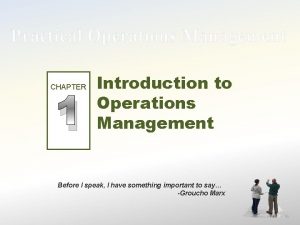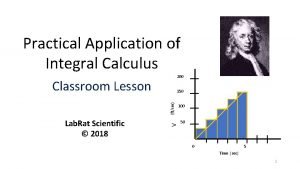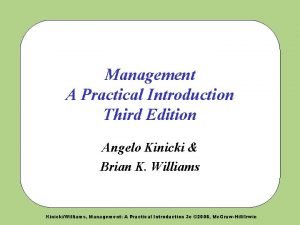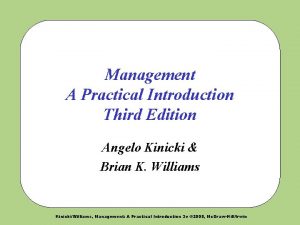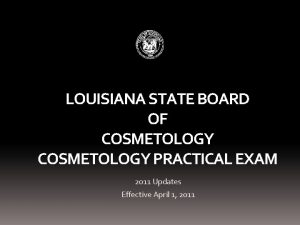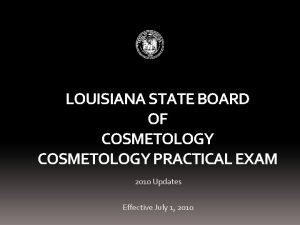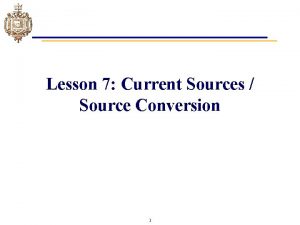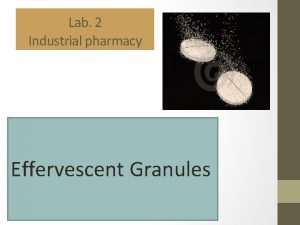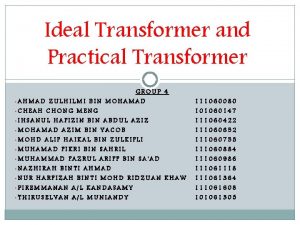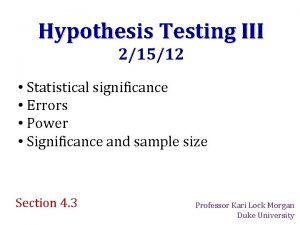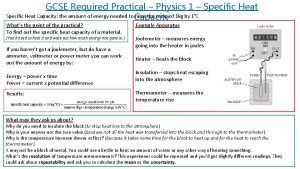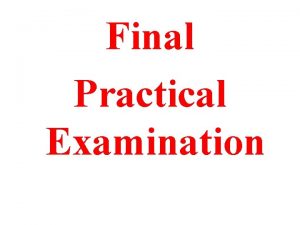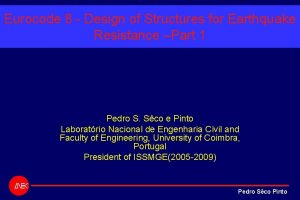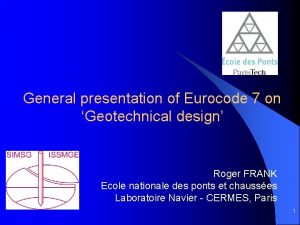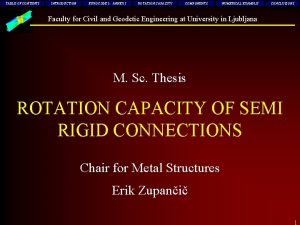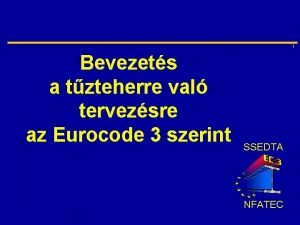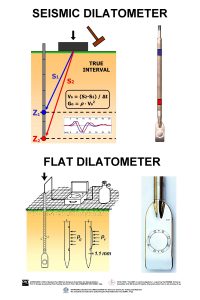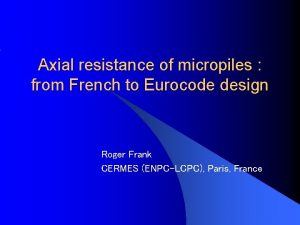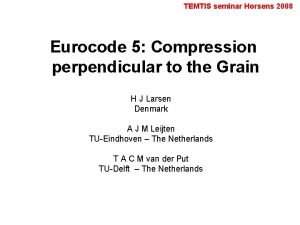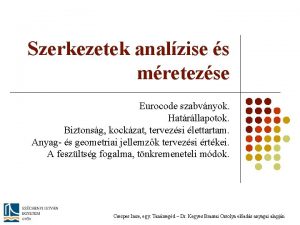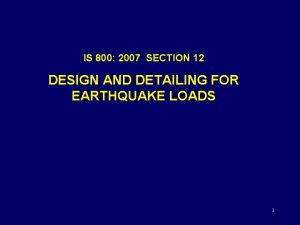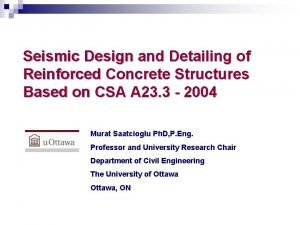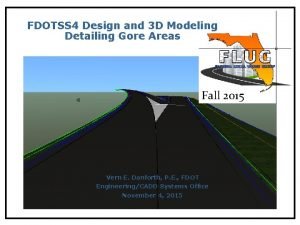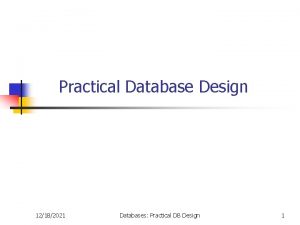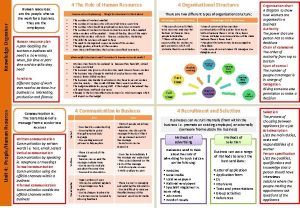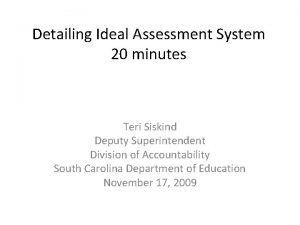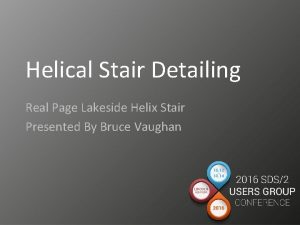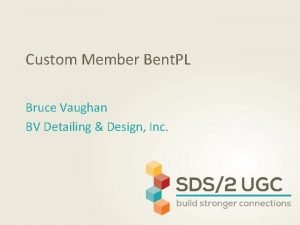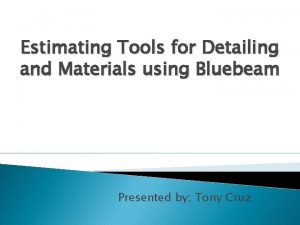Practical Design to Eurocode 2 Lecture 7 Detailing







































































- Slides: 71

Practical Design to Eurocode 2 Lecture 7 – Detailing The webinar will start at 12. 30 EC 2 Section 8 - Detailing of Reinforcement - General Rules Bar spacing, Minimum bend diameter Anchorage of reinforcement Lapping of bars EC 2 Section 9 – Detailing of Members and Particular Rules Beams Solid slabs Tying Systems

Course Outline Lecture Date Speaker Title 1 21 Sep Charles Goodchild Introduction, Background and Codes 2 3 28 Sep Charles Goodchild EC 2 Background, Materials, Cover and effective spans 5 Oct Paul Gregory Bending and Shear in Beams 4 12 Oct Charles Goodchild Analysis 5 19 Oct Paul Gregory 6 26 Oct Charles Goodchild Deflection and Crack Control 7 2 Nov Paul Gregory Detailing 8 9 Nov Jenny Burridge Columns 9 16 Nov Jenny Burridge Fire 10 23 Nov Jenny Burridge Foundations Slabs and Flat Slabs

Model Answers for Lecture 6 Exercise: Deflection & Cracking

Design Exercise: Check deflection in this columnstrip span For the same slab check the strip indicated to verify that: • deflection is OK and • the crack widths in the bottom are also limited. As before: As, req = 959 mm 2/m B d = 240 mm γG = 1. 25 gk = 8. 5 k. N/m 2 qk = 4. 0 k. N/m 2 fck = 30 MPa

Deflection Model answer Check: basic l/d x F 1 x F 2 x F 3 actual l/d 1. Determine basic l/d The reinforcement ratio, = As, req/bd = 959 x 100/(1000 x 240) = 0. 40%

Basic Span-to-Depth Ratios (for simply supported condition) Model answer How To 3: Figure 5 Span to depth ratio (l/d) This graph has been produced for K = 1. 0 26. 0 0. 4% Percentage of tension reinforcement (As, req’d/bd) Structural System K Simply supported 1. 0 End span 1. 3 Interior Span 1. 5 Flat Slab 1. 2

Deflection Model answer 7. 4. 2 EN 1992 -1 -1 Check: basic l/d x F 1 x F 2 x F 3 actual l/d 1. Determine basic l/d The reinforcement ratio, = As, req/bd = 959 x 100/(1000 x 240) = 0. 40% From graph basic l/d = 26. 0 x 1. 2 = 31. 2 (K = 1. 2 for flat slab) 2. Determine Factor F 1 = 1. 0 3. Determine Factor F 2 = 1. 0 For flanged sections where the ratio of the flange breadth to the rib breadth exceeds 3, the values of l/d given by Expression (7. 16) should be multiplied by 0. 8. For flat slabs, with spans exceeding 8. 5 m, which support partitions liable to be damaged by excessive deflections, the values of l/d given by Expression (7. 16) should be multiplied by 8. 5 / leff (leff in metres, see 5. 3. 2. 2 (1)).

Deflection Model answer 4. Determine Factor F 3 Steel stress under service load: use As, prov/As, req ≤ 1. 5 As, req = 959 mm 2 (ULS) Assume we require H 16 @ 200 c/c (1005 mm 2) to control deflection F 3 = As, prov / As, req = 1005 / 959 = 1. 05 ≤ 1. 5 Allowable 31. 2 x 1. 05 32. 8 vs Actual 5900 / 240 24. 5 OK!

y Factors Model answer Action Imposed loads in buildings, Category A : domestic, residential Category B : office areas Category C : congregation areas Category D : shopping areas Category E : storage areas Category F : traffic area, 30 k. N Category G : traffic area, 30– 160 k. N Category H : roofs Snow load: H 1000 m a. s. l. Wind loads on buildings y 0 y 1 y 2 0. 7 1. 0 0. 7 0. 5 0. 7 0. 9 0. 7 0. 5 0 0, 2 0. 3 0. 6 0. 8 0. 6 0. 3 0 0 0

Determination of Steel Stress Model answer Unmodified steel stress, su Ratio Gk/Qk = 8. 5/4. 0 = 2. 13 252 Ratio Gk/Qk

Crack Widths Model answer From graph ssu = 252 MPa Maximum bar size or spacing to limit crack width ss Steel stress wmax = 0. 3 mm (σs) MPa Maximum bar size bar spacing (mm) = (ssu As, req) / (d As, prov) ss = (252 x 959) /(1. 0 x 1005) = 240 MPa For H 16 @ 200 c/c Design meets both criteria 160 32 300 25 240 16 280 12 150 320 10 100 360 8 50 For loading or restraint For loading only OR 250 200

Detailing Lecture 7 2 nd November 2016

Reinforced Concrete Detailing to Eurocode 2 EC 2 Section 8 - Detailing of Reinforcement - General Rules Bar spacing, Minimum bend diameter Anchorage of reinforcement Lapping of bars Large bars, bundled bars EC 2 Section 9 - Detailing of Members and Particular rules Beams Solid slabs Flat slabs Columns Walls Deep beams Foundations Discontinuity regions Tying Systems

Section 8 - General Rules Spacing of bars EC 2: Cl. 8. 2 Concise: 11. 2 • Clear horizontal and vertical distance , (dg +5 mm) or 20 mm • For separate horizontal layers the bars in each layer should be located vertically above each other. There should be room to allow access for vibrators and good compaction of concrete. Detail Min 75 mm gap

Min. Mandrel Dia. for bent bars Concise: 11. 3 EC 2: Cl. 8. 3 Minimum mandrel size, m • To avoid damage to bar is Bar dia 16 mm Mandrel size 4 x bar diameter Bar dia > 16 mm Mandrel size 7 x bar diameter The bar should extend at least 5 diameters beyond a bend m BS 8666 aligns

Min. Mandrel Dia. for bent bars EC 2: Cl. 8. 3 Concise: 11. 3 Minimum mandrel size, m Bearing stress inside bends • To avoid failure of the concrete inside the bend of the bar: m, min Fbt ((1/ab) +1/(2 )) / fcd Fbt ultimate force in a bar at the start of a bend ab for a given bar is half the centre-to-centre distance between bars. For a bar adjacent to the face of the member, ab should be taken as the cover plus /2 Mandrel size need not be checked to avoid concrete failure if : – anchorage does not require more than 5 past end of bend – bar is not the closest to edge face and there is a cross bar inside bend – mandrel size is at least equal to the recommended minimum value

Anchorage of reinforcement EC 2: Cl. 8. 4

Ultimate bond stress EC 2: Cl. 8. 4. 2 Concise: 11. 5 The design value of the ultimate bond stress, fbd = 2. 25 1 2 fctd where fctd should be limited to C 60/75 1 = 1 for ‘good’ and 0. 7 for ‘poor’ bond conditions 2 = 1 for 32, otherwise (132 - )/100

Ultimate bond stress Concise: 11. 5 EC 2: Cl. 8. 4. 2 Good and ‘bad’ bond conditions a) 45º 90º c) h > 250 mm 300 b) h 250 mm d) h > 600 mm unhatched zone – ‘good’ bond conditions hatched zone - ‘poor’ bond conditions Top is ‘poor’ Bond condition

Basic required anchorage length EC 2: Cl. 8. 4. 3 Concise: 11. 4. 3 lb, rqd = ( / 4) ( sd / fbd) where sd = the design stress of the bar at the position from where the anchorage is measured. For bent bars lb, rqd should be measured along the centreline of the bar EC 2 Figure 8. 1 Concise Fig 11. 1

Design Anchorage Length, lbd EC 2: Cl. 8. 4. 4 Concise: 11. 4. 2 lbd = α 1 α 2 α 3 α 4 α 5 lb, rqd lb, min However: (α 2 α 3 α 5) 0. 7 lb, min > max(0. 3 lb, rqd ; 10 , 100 mm) Alpha values are in EC 2: Table 8. 2 To calculate α 2 and α 3 Table 8. 2 requires values for: Cd Value depends on cover and bar spacing, see Figure 8. 3 K Factor depends on position of confinement reinforcement, see Figure 8. 4 λ = (∑Ast – ∑ Ast, min)/ As Where Ast is area of transverse reinf.

Table 8. 2 - Cd & K factors EC 2: Figure 8. 3 EC 2: Figure 8. 4 Beam corner bar? Concise: Figure 11. 3

Table 8. 2 - Other than straight shapes EC 2: Figure 8. 1 Concise: Figure 11. 1

Alpha values EC 2: Table 8. 2 α 1 α 2 α 3 α 4 α 5 Concise: 11. 4. 2

Anchorage of links EC 2: Cl. 8. 5 Concise: Fig 11. 2

Laps EC 2: Cl. 8. 7

Design Lap Length, l 0 (8. 7. 3) EC 2: Cl. 8. 7. 3, Table 8. 3 Concise: 11. 6. 2 l 0 = α 1 α 2 α 3 α 5 α 6 lb, rqd l 0, min α 1 α 2 α 3 α 5 are as defined for anchorage length α 6 = ( 1/25)0, 5 but between 1. 0 and 1. 5 where 1 is the % of reinforcement lapped within 0. 65 l 0 from the centre of the lap Percentage of lapped bars relative to the total crosssection area α 6 < 25% 33% 50% >50% 1 1. 15 1. 4 1. 5 Note: Intermediate values may be determined by interpolation. l 0, min max{0. 3 α 6 lb, rqd; 15 ; 200}

Arrangement of Laps EC 2: Cl. 8. 7. 3, Fig 8. 8

Worked example Anchorage and lap lengths

Anchorage Worked Example Calculate the tension anchorage for an H 16 bar in the bottom of a slab: a) Straight bars b) Other shape bars (Fig 8. 1 b, c and d) Concrete strength class is C 25/30 Nominal cover is 25 mm Assume maximum design stress in the bar

Bond stress, fbd = 2. 25 η 1 η 2 fctd EC 2 Equ. 8. 2 η 1 = 1. 0 ‘Good’ bond conditions η 2 = 1. 0 bar size ≤ 32 fctd = αct fctk, 0, 05/γc αct = 1. 0 EC 2 cl 3. 1. 6(2), Equ 3. 16 γc = 1. 5 fctk, 0, 05 = 0. 7 x 0. 3 fck 2/3 = 0. 21 x 252/3 = 1. 795 MPa fctd = αct fctk, 0, 05/γc = 1. 795/1. 5 = 1. 197 fbd = 2. 25 x 1. 197 = 2. 693 MPa EC 2 Table 3. 1

Basic anchorage length, lb, req lb. req = (Ø/4) ( σsd/fbd) EC 2 Equ 8. 3 Max stress in the bar, σsd = fyk/γs = 500/1. 15 = 435 MPa. lb. req = (Ø/4) ( 435/2. 693) = 40. 36 Ø For concrete class C 25/30

Design anchorage length, lbd = α 1 α 2 α 3 α 4 α 5 lb. req ≥ lb, min lbd = α 1 α 2 α 3 α 4 α 5 (40. 36Ø) For concrete class C 25/30

Alpha values EC 2: Table 8. 2 Concise: 11. 4. 2

Table 8. 2 - Cd & K factors EC 2: Figure 8. 3 EC 2: Figure 8. 4 Concise: Figure 11. 3

Design anchorage length, lbd = α 1 α 2 α 3 α 4 α 5 lb. req ≥ lb, min lbd = α 1 α 2 α 3 α 4 α 5 (40. 36Ø) For concrete class C 25/30 a) Tension anchorage – straight bar α 1 = 1. 0 α 3 = 1. 0 conservative value with K= 0 α 4 = 1. 0 N/A α 5 = 1. 0 conservative value α 2 = 1. 0 – 0. 15 (Cd – Ø)/Ø α 2 = 1. 0 – 0. 15 (25 – 16)/16 = 0. 916 lbd = 0. 916 x 40. 36Ø = 36. 97Ø = 592 mm

Design anchorage length, lbd = α 1 α 2 α 3 α 4 α 5 lb. req ≥ lb, min lbd = α 1 α 2 α 3 α 4 α 5 (40. 36Ø) For concrete class C 25/30 b) Tension anchorage – Other shape bars α 1 = 1. 0 Cd = 25 is ≤ 3 Ø = 3 x 16 = 48 α 3 = 1. 0 conservative value with K= 0 α 4 = 1. 0 N/A α 5 = 1. 0 conservative value α 2 = 1. 0 – 0. 15 (Cd – 3Ø)/Ø ≤ 1. 0 α 2 = 1. 0 – 0. 15 (25 – 48)/16 = 1. 25 ≤ 1. 0 lbd = 1. 0 x 40. 36Ø = 646 mm

Worked example - summary H 16 Bars – Concrete class C 25/30 – 25 Nominal cover Tension anchorage – straight bar lbd = 36. 97Ø = 592 mm Tension anchorage – Other shape bars lbd = 40. 36Ø = 646 mm lbd is measured along the centreline of the bar Compression anchorage (α 1 = α 2 = α 3 = α 4 = α 5 = 1. 0) lbd = 40. 36Ø = 646 mm Anchorage for ‘Poor’ bond conditions, lbd = ‘Good value’ /0. 7 Lap length, l 0 = anchorage length x α 6

Anchorage & lap lengths How to design concrete structures using Eurocode 2 Column lap length for 100% laps & grade C 40/50 = 0. 73 x 61 Ф = 44. 5 Ф

Anchorage /lap lengths for slabs Manual for the design of concrete structures to Eurocode 2 Table 5. 25: Typical values of anchorage and lap lengths for slabs Bond Length in bar diameters conditions fck /fcu 25/30 fck /fcu 28/35 fck /fcu 30/37 fck /fcu 32/40 Full tension and compression anchorage length, lbd ‘good’ 40 37 36 34 ‘poor’ 58 53 51 49 Full tension and compression lap length, l 0 ‘good’ 46 43 42 39 ‘poor’ 66 61 59 56 Note: The following is assumed: - bar size is not greater than 32 mm. If >32 then the anchorage and lap lengths should be increased by a factor (132 - bar size)/100 - normal cover exists - no confinement by transverse pressure - no confinement by transverse reinforcement - not more than 33% of the bars are lapped at one place Lap lengths provided (for nominal bars, etc. ) should not be less than 15 times the bar size or 200 mm, whichever is greater.

Arrangement of Laps EC 2: Cl. 8. 7. 2 Concise: Cl 11. 6 Laps between bars should normally be staggered and not located in regions of high stress. Arrangement of laps should comply with Figure 8. 7: Distance ‘a’ is used in cl 8. 7. 4. 1 (3), Transverse reinf. All bars in compression and secondary (distribution) reinforcement may be lapped in one section.

Transverse Reinforcement at Laps Concise: Cl 11. 6. 4 Bars in tension EC 2: Cl. 8. 7. 4, Fig 8. 9 • Transverse reinforcement is required in the lap zone to resist transverse tension forces. • Any Transverse reinforcement provided for other reasons will be sufficient if the lapped • bar Ø < 20 mm or laps< 25% If the lapped bar Ø ≥ 20 mm the transverse reinforcement should have a total area, Ast 1, 0 As of one spliced bar. It should be placed perpendicular to the direction of the lapped reinforcement. Also it should be positioned at the outer sections of the lap as shown. Figure 8. 9 (a) bars in tension

Transverse Reinforcement at Laps Concise: Cl 11. 6. 4 Bars in tension EC 2: Cl. 8. 7. 4, Fig 8. 9 • Also, if the lapped bar Ø ≥ 20 mm and more than 50% of the reinforcement is lapped at one point and the distance between adjacent laps at a section, a, 10 , then transverse bars should be formed by links or U bars anchored into the body of the section.

Transverse Reinforcement at Laps Bars in compression Concise: Cl 11. 6. 4 EC 2: Cl. 8. 7. 4, Fig 8. 9 In addition to the rules for bars in tension one bar of the transverse reinforcement should be placed outside each end of the lap length. Figure 8. 9 (b) – bars in compression

Detailing of members and particular rules EC 2 Section 9

Beams EC 2: Cl. 9. 2 • As, min = 0, 26 (fctm/fyk)btd but 0, 0013 btd • As, max = 0, 04 Ac • Section at supports should be designed for a hogging moment 0, 25 max. span moment • Any design compression reinforcement ( ) should be held by transverse reinforcement with spacing 15

Beams EC 2: Cl. 9. 2 • Tension reinforcement in a flanged beam at supports should be spread over the effective width (see 5. 3. 2. 1)

Curtailment EC 2: Cl. 9. 2. 1. 3 (1) Sufficient reinforcement should be provided at all sections to resist the envelope of the acting tensile force, including the effect of inclined cracks in webs and flanges. (2) For members with shear reinforcement the additional tensile force, ΔFtd, should be calculated according to 6. 2. 3 (7). For members without shear reinforcement ΔFtd may be estimated by shifting the moment curve a distance al = d according to 6. 2. 2 (5). This "shift rule” may also be used as an alternative for members with shear reinforcement, where: al = z (cot θ - cot α)/2 = 0. 5 z cot θ for vertical shear links z= lever arm, θ = angle of compression strut al = 1. 125 d when cot θ = 2. 5 and 0. 45 d when cot θ = 1

‘Shift Rule’ for Shear Curtailment of longitudinal tension reinforcement Horizontal component of diagonal shear force M/z - V cot /2 = (V/sin ). cos = V cot V/sin z M/z + V cot /2 al Applied shear V moment M = (M + Vz cot /2)/z M = Vz cot /2 d. M/dx = V M = V x x = z cot /2 = al

‘Shift Rule’ Curtailment of reinforcement EC 2: Cl. 9. 2. 1. 3, Fig 9. 2 Concise: 12. 2. 2 al • For members without shear reinforcement this is satisfied with al = d • For members with shear reinforcement: al = 0. 5 z Cot But it is always conservative to use al = 1. 125 d (for = 45 o, al = 0. 45 d)

Anchorage of Bottom Reinforcement at End Supports EC 2: Cl. 9. 2. 1. 4 • As bottom steel at support 0. 25 As provided in the span • lbd is required from the line of contact of the support. • Transverse pressure may only be taken into account with a ‘direct’ support. α 5 anchorage coefficient

Simplified Detailing Rules for Beams Concise: Cl 12. 2. 4 How to…. EC 2 Detailing section

Supporting Reinforcement at ‘Indirect’ Supports Concise: Cl 12. 2. 8 EC 2: Cl. 9. 2. 5 A B supporting beam with height h 1 supported beam with height h 2 (h 1 h 2) Plan view • The supporting reinforcement is in addition to that required for other reasons • The supporting links may be placed in a zone beyond the intersection of beams

Solid slabs EC 2: Cl. 9. 3 • Curtailment – as beams except for the “Shift” rule al = d may be used • Flexural Reinforcement – min and max areas as beam • Secondary transverse steel not less than 20% main reinforcement • Reinforcement at Free Edges

Detailing Comparisons Beams EC 2 BS 8110 Main Bars in Tension Clause / Values As, min 9. 2. 1. 1 (1): 0. 0013 bd 0. 26 fctm/fykbd 0. 0013 bh As, max 9. 2. 1. 1 (3): 0. 04 bd 0. 04 bh Main Bars in Compression As, min -- 0. 002 bh As, max 9. 2. 1. 1 (3): 0. 04 bd 0. 04 bh Spacing of Main Bars dg + 5 mm or 20 mm smin 8. 2 (2): Smax Table 7. 3 N dg + 5 mm or Table 3. 28 Links Asw, min 9. 2. 2 (5): (0. 08 b s fck)/fyk 0. 4 b s/0. 87 fyv sl, max 9. 2. 2 (6): 0. 75 d 0. 75 d st, max 9. 2. 2 (8): 0. 75 d 600 mm d or 150 mm from main bar 9. 2. 1. 2 (3) or 15 from main bar

Detailing Comparisons Slabs EC 2 Clause / Values BS 8110 Values Main Bars in Tension As, min 9. 2. 1. 1 (1): 0. 26 fctm/fykbd 0. 0013 bd 0. 0013 bh As, max 0. 04 bd 0. 04 bh Secondary Transverse Bars As, min 9. 3. 1. 1 (2): 0. 2 As for single way slabs 0. 002 bh As, max 9. 2. 1. 1 (3): 0. 04 bh 0. 04 bd Spacing of Bars smin 8. 2 (2): dg + 5 mm or 20 mm 9. 3. 1. 1 (3): main 3 h 400 mm dg + 5 mm or Smax secondary: 3. 5 h 450 mm 3 d or 750 mm places of maximum moment: main: 2 h 250 mm secondary: 3 h 400 mm

Detailing Comparisons Punching Shear EC 2 Clause / Values BS 8110 Values Links Asw, min 9. 4. 3 (2): Link leg = 0. 053 sr st (fck)/fyk Total = 0. 4 ud/0. 87 fyv Sr 9. 4. 3 (1): 0. 75 d St 9. 4. 3 (1): within 1 st control perim. : 1. 5 d outside 1 st control perim. : 2 d 0. 75 d 1. 5 d Columns Main Bars in Compression As, min 9. 5. 2 (2): 0. 10 NEd/fyk 0. 002 bh 0. 004 bh As, max 9. 5. 2 (3): 0. 06 bh 0. 04 bh Links Min size 9. 5. 3 (1) 0. 25 or 6 mm Scl, tmax 9. 5. 3 (3): min(12 min; 0. 6 b; 240 mm) 12 9. 5. 3 (6): 150 mm from main bar

Identification of bars on site Current BS 4449 Class A Class B Class C www. ukcares. co. uk www. uk-bar. org

Identification on site Current BS 4449 UK CARES (Certification - Product & Companies) 1. 2. 3. 4. 5. Reinforcing bar and coil Reinforcing fabric Steel wire for direct use of for further processing Cut and bent reinforcement Welding and prefabrication of reinforcing steel

Detailing Issues EC 2 Clause Issue Possible resolve in 2017? 8. 4. 4. 1 Lap lengths Table 8. 3 a 6 varies depending on a 6 should always = 1. 5. amount staggered Staggering doesn’t help at ULS 8. 7. 2(3) & Fig 8. 7 0. 3 lo gap between ends of lapped bars is onerous. For ULS, there is no advantage in staggering bars( fib bulletin Mar 2014). For SLS staggering at say 0. 5 lo might be helpful.

Detailing Issues EC 2 Clause Issue Possible resolve in 2017? Table 8. 2 a 2 for compression bars Should be the same as for tension. Initial test suggests a 2 = 0. 7 Table 8. 2 a 2 for bent bars Currently, anchorage worse than for straight bars 8. 7. 4. 1(4) Requirements for & Fig 8. 9 transverse bars are impractical Requirement only makes 10 -15% difference in strength of lap Fig 9. 3 lbd anchorage into support May be OTT as compression forces increase bond strength. Issue about anchorage beyond CL of support 6. 4 Numbers of perimeters of punching shear links Work of CEN TC 250. SC 2/WG 1/TG 4 (Corrigendum 1 no longer requires transverse bars to be between lapped bar and surface. )

Tying systems

Tying systems • Peripheral ties (9. 10. 2. 2) & NA: Ftie, per = (20 + 4 n 0) 60 k. N where n 0 is the number of storeys • Internal ties (including transverse ties) (9. 10. 2. 3) & NA : Ftie, int = ((gk + qk) / 7. 5 )(lr/5)Ft Ft k. N/m where (gk + qk) is the sum of the average permanent and variable floor loads (k. N/m 2), lr is the greater of the distances (m) between the centres of the columns, frames or walls supporting any two adjacent floor spans in the direction of the tie under consideration and Ft = (20 + 4 n 0) 60 k. N. Maximum spacing of internal ties = 1. 5 lr • Horizontal ties to columns or walls (9. 10. 2. 4) & NA : Ftie, fac = Ftie, col (2 Ft (ls /2. 5)Ft) and 3% of NEd = the total design ultimate vertical load carried by the column or wall at that level. Tying of external walls is only required if the peripheral tie is not located within the wall. Ftie, fac in k. N per metre run of wall, Ftie, col in k. N per column and ls is the floor to ceiling height in m.

Tying Systems Internal Ties: EC 2 specifies a 20 k. N/m requirement which is significantly less than BS 8110. UK NA requirements similar to BS 8110

Tying Systems • Vertical ties (9. 10. 2. 5): In panel buildings of 5 storeys or more, ties should be provided in columns and/or walls to limit damage of collapse of a floor. Normally continuous vertical ties should be provided from the lowest to the highest level. Where a column or wall is supported at the bottom by a beam or slab accidental loss of this element should be considered. • Continuity and anchorage ties (9. 10. 3): Ties in two horizontal directions shall be effectively continuous and anchored at the perimeter of the structure. Ties may be provided wholly in the insitu concrete topping or at connections of precast members.

Exercise Lecture 9 Lap length for column longitudinal bars

Column lap length exercise Design information H 25’s • C 40/50 concrete • 400 mm square column • 45 mm nominal cover to main bars Lap • Longitudinal bars are in compression • Maximum ultimate stress in the bars is 390 MPa Exercise: Calculate the minimum lap length using EC 2 equation 8. 10: H 32’s

Column lap length exercise Procedure • Determine the ultimate bond stress, fbd EC 2 Equ. 8. 2 • Determine the basic anchorage length, lb, req EC 2 Equ. 8. 3 • Determine the design anchorage length, lbd EC 2 Equ. 8. 4 • Determine the lap length, l 0 = anchorage length x α 6

Working space

Working space

End of Lecture 7
 Practical design to eurocode 2
Practical design to eurocode 2 Eurocode
Eurocode Eurocode
Eurocode Eurocode
Eurocode Eurocode
Eurocode Bbn detailing - mobile
Bbn detailing - mobile Parapet wall flat roof detail
Parapet wall flat roof detail Column starter bars
Column starter bars Cantilever balcony reinforcement
Cantilever balcony reinforcement Stamm auto detailing
Stamm auto detailing Detailing connect
Detailing connect Dalhousie academic detailing
Dalhousie academic detailing Mark receives a score report detailing his performance
Mark receives a score report detailing his performance Download sds 2 software
Download sds 2 software Academic detailing definition
Academic detailing definition 01:640:244 lecture notes - lecture 15: plat, idah, farad
01:640:244 lecture notes - lecture 15: plat, idah, farad What is a costume
What is a costume Performance based practical design
Performance based practical design Urban design lecture
Urban design lecture Interior design lecture notes+ppt
Interior design lecture notes+ppt Lecture hall acoustics
Lecture hall acoustics Game design lecture
Game design lecture Computer aided drug design lecture notes
Computer aided drug design lecture notes Cmos vlsi design lecture notes
Cmos vlsi design lecture notes Practical/logistical issues in relationships
Practical/logistical issues in relationships Understanding ekgs a practical approach
Understanding ekgs a practical approach Practical factors sociology
Practical factors sociology Tcp/ip sockets in java
Tcp/ip sockets in java Practical significance example
Practical significance example Practically significant
Practically significant Salters advanced chemistry
Salters advanced chemistry Nat 5 practical cookery
Nat 5 practical cookery Earth science practical review
Earth science practical review Daily life polynomials in real life
Daily life polynomials in real life Other practical applications of boyle's law
Other practical applications of boyle's law Factor label definition
Factor label definition Multipicand
Multipicand Practical research inquiry
Practical research inquiry Practical operations management
Practical operations management Human karyotype practical
Human karyotype practical Practical meta-analysis
Practical meta-analysis Practical investment management
Practical investment management Practical functional assessment
Practical functional assessment Stix mitre
Stix mitre Practical criticism solved examples
Practical criticism solved examples Practical application of calculus
Practical application of calculus Practical extraction and reporting language
Practical extraction and reporting language The detective needs more time to inquire about the case
The detective needs more time to inquire about the case Practical intelligence definition
Practical intelligence definition Modifiers of human act examples
Modifiers of human act examples Vce biology poster
Vce biology poster Kinicki management a practical introduction
Kinicki management a practical introduction Read management: a practical introduction online
Read management: a practical introduction online 90 degree haircut state board
90 degree haircut state board La state board of cosmetology
La state board of cosmetology Grade 10 life science transpiration practical
Grade 10 life science transpiration practical Practical current source
Practical current source Earth science regents lab practical
Earth science regents lab practical Earth science lab practical
Earth science lab practical Describe the method of preparation of effervescent granules
Describe the method of preparation of effervescent granules Examples of practical intelligence
Examples of practical intelligence Intelligence z
Intelligence z Difference between ideal and practical transformer
Difference between ideal and practical transformer Practical significance
Practical significance Nccco testing sites
Nccco testing sites Natural science grade 4 term 2 test papers
Natural science grade 4 term 2 test papers Specific heat capacity practical
Specific heat capacity practical Ccea gce chemistry practical support
Ccea gce chemistry practical support Final practical
Final practical Earth science lab practical
Earth science lab practical Icass practical assessment task 2 2017 memorandum
Icass practical assessment task 2 2017 memorandum Strategic gender needs and practical gender needs
Strategic gender needs and practical gender needs

